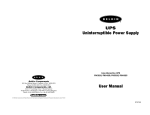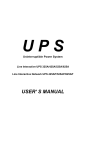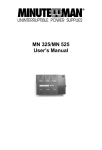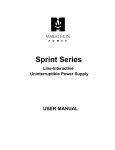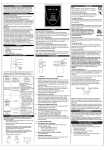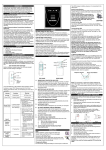Download Belkin F6C625-220V User manual
Transcript
P73446-B UPS Uninterruptible Power Supply User Manual Important Safety Instructions Presentation (continued) Thank you for purchasing the Belkin Uninterruptible Power Supply (UPS). It will provide you with the best protection for your connected equipment. Please read this manual! This manual provides safety, installation, and operating instructions that will help you obtain the highest performance and service life that the UPS has to offer. Please save this manual! It includes important instructions for the safe use of this UPS and for obtaining factory service should the proper operation of the UPS come into question. Please save or recycle the packaging materials! The UPS shipping materials were designed with great care to provide protection from transportation-related damage. These materials are invaluable if you ever have to return the UPS for service. Damage sustained during transit is not covered under the warranty. Responsible Party: Belkin Components, Ltd. Unit 13 • Gatelodge Close • Round Spinney Northampton • Northants • NN3 8RX United Kingdom Tel: +44 (0) 1604678300 Fax: +44 (0) 1604678330 Belkin Components B.V. Diamantlaan 8 • 2132 WV Hoofddorp • The Netherlands Tel: +31 (0) 235698765 Fax: +31 (0) 235612694 REAR PANEL (continued) 3.6 TELEPHONE/FAX/MODEM OR 10Base-T NETWORK PROTECTION Telephone/Fax/Modem lines are surge protected and provide complete safety for Internet connection. One input and two outputs allow for two devices to be protected (i.e. modem and fax). 3.7 BATTERY REPLACE DOOR (HOT-SWAPPABLE) 3.8 SITE WIRING FAULT INDICATOR The Site Wiring Fault LED will illuminate when one of the following conditions exist: Have you ever noticed your lights dim or flicker when you turn on your dishwasher or air-conditioning? This common occurrence is attributed to an under-voltage of power, also known as a BROWNOUT. Note: During the self-test, the UPS briefly operates the loads on-battery (the onbattery LED comes on). If the UPS passes the self-test, it returns to online operation. The on-battery LED goes off and the on-line LED goes on steady. If the UPS fails the self-test, it immediately returns to on-line operation and lights the “REPLACE BATTERY” LED. The loads are not affected. Recharge the battery overnight and perform the self-test again. If the “REPLACE BATTERY” LED is still on, the battery will need to be replaced. 5.3 1. Open or high-resistance ground 2. Hot and neutral polarity reversal 3. Overloaded neutral circuit 3.9 AC INPUT POWER RECEPTACLE 3.10 AC BREAKER (CIRCUIT BREAKER) The circuit breaker button will stick out if an overload condition forces the UPS to disconnect itself from utility power. If the button sticks out, disconnect non-essential equipment. 3.11 BATTERY BACK-UP OUTLET Data-sensitive equipment, such as a computer, monitor, and external drive should be powered by these outlets. Battery power is automatically provided in case of a power outage. Power (utility or battery) is not supplied to these outlets when the UPS is switched off. (Do not plug surge protectors or power strips into the battery back-up outlets.) Introduction Operation (continued) Note: In back-up mode, the UPS can be automatically turned off if none of the connected loads are operating. Alarm 6.0 BACK-UP (slow alarm) When in "BACK-UP" mode, the yellow LED illuminates and the UPS sounds an audible alarm. The alarm stops when the UPS returns to “LINE NORMAL” operation. 6.1 3.12 SURGE-ONLY PROTECTED OUTLETS Equipment such as a printer, fax machine, scanner, or desk lamp should be powered by these outlets. These outlets do not provide power during a power outage. These outlets are always on (when utility power is available) and are not controlled by the front panel switches. LOW BATTERY (rapid alarm) In "BACK-UP" mode, when the battery energy runs low, the UPS beeps rapidly until the UPS shuts down from a depleted battery or returns to “LINE NORMAL” operation. 6.2 OVERLOAD (continuous alarm) When the UPS is overloaded (the connected loads exceed the maximum rated capacity), the UPS emits a continuous alarm to warn of an overload condition. Disconnect nonessential equipment from the UPS to eliminate the overload. Installation 6.3 FAULT (30 seconds continuously) When the output is shorted, the UPS emits a 30-second continuous alarm to warn of a short condition. A brownout is a period of insufficient power-line voltage. It is the most common power problem, accounting for 80% of all power disturbances. Effects: A brownout can deprive a computer of the power it needs to function, causing unwanted damage to your computer, such as frozen keyboards and hard drive crashes. Such problems will cause you to incur computer repairs, lost data, and downtime. Disconnect the equipment from the UPS prior to checking the equipment. Solution: A Belkin Uninterruptible Power Supply (UPS) with Automatic Voltage Regulation (AVR). Typical "Stand-by" UPS units do not have AVR to increase the output voltage or decrease the output voltage to your computer. A surge protector can only protect your computer from over-voltages due to irregular power. Belkin UPS units protect against surges, spikes, swells, line-noise, brownouts, and blackouts! Software Options 7.0 Only a Belkin UPS with AVR can give your computer clean and consistent power at all times. Note: There is no guarantee that interference to radio/TV will not occur in a particular installation. If this UPS causes interference to radio or television reception (this can be determined by turning the UPS power off and on), the user is encouraged to try to correct the interference by one or more of the following measures: 4.0 Inspection Inspect the UPS upon receipt. The packaging is recyclable; save it for reuse or dispose of it properly. 4.1 Placement Install the UPS in a protected area with adequate air flow and free of excessive dust. Do not operate the UPS where the temperature and humidity are beyond the specified limits. • Connect the equipment to an outlet on a circuit different from that to which the receiver is connected. • Increase the separation between the equipment and the receiver. • Reorient or relocate the receiving antenna. 4.2 Connect Computer Interface Belkin Sentry Bulldog Shutdown Management Software and the USB or RS232 DB9 cable (depending on model) can be used with this UPS. If used, connect the interface cable to the computer interface port on the back panel of the UPS and then connect to the USB or Serial port on your PC. 4.3 Connect to Utility Connect the AC input power connector to utility power to power up the UPS. Safety CAUTION! To reduce the risk of electric shock, disconnect the UPS from the main power supply before installing a computer interface signal cable. Reconnect the power cord only after signaling interconnections have been made. 4.4 Charge the Battery The UPS charges its battery whenever it is connected to the utility power. For best results, charge the battery for 4 hours prior to initial use. 4.5 Connect the Loads Plug the loads into the output connectors on the rear of the UPS. To use the UPS as a master on/off switch, make sure all of the loads are switched on. 4.6 Cable Management It is used to corral all of the power cords into a neat and safe order. It also assists in preventing accidental cord detachment. CAUTION! The internal energy source (the battery) cannot be de-energized by the user. The output may be energized when the unit is not connected to a main power supply, thus, a shock hazard may be present. CAUTION! (RISK OF ELECTRIC SHOCK) HAZARDOUS LIVE PARTS INSIDE THIS UNIT ARE ENERGIZED FROM THE BATTERY SUPPLY EVEN WHEN THE INPUT AC POWER IS NOT CONNECTED. SILENCE In " BACK-UP" mode, push on/off/test less than 3 seconds to silence the audible alarm. (The function is void when under condition of "LOW BATTERY" or "OVERLOAD".) CAUTION! (RISK OF ELECTRIC SHOCK) DO NOT REMOVE COVER. NO USER SERVICEABLE PARTS INSIDE, PLEASE REFER SERVICING TO QUALIFIED SERVICE PERSONNEL. Belkin Sentry Bulldog Shutdown Management Software Belkin Sentry Bulldog Shutdown Management Software receives communication through the USB or RS232 interface port (depending on model) to perform monitoring functions, and also provide an orderly shutdown of the computer in the event of a power failure. Moreover, Belkin Sentry Bulldog Shutdown Management Software displays all of the diagnostic symptoms on screen, such as Voltage level, Frequency, Battery level, etc. The software is available for Windows® 95, Windows® 98, Windows NT® V4 or higher, and Windows® 2000. 7.1 Interface Kits Each interface kit includes a special interface cable which is required to convert status signals from the UPS into signals that the individual operating system can recognize. The interface cable must be connected to the USB or RS232 port (depending on model) on the UPS. The other side of the interface cable can be connected to the USB or RS232 port (depending on model) of your PC. For other installation instructions and features, please refer to the README file. CAUTION: Use only a factory supplied or authorized UPS monitoring cable! 7.2 USB (Universal Serial Bus): HID (Human Interface Device) setup procedure 1. When the USB cable that comes with the UPS is first connected to a USB port on your computer, the Windows® 98 dialog called “ADD NEW HARDWARE WIZARD” should appear automatically. (To display this dialog manually, you can choose the Start button and then “Settings” to access the Control Panel and then double-click “ADD NEW HARDWARE”. The USB cable should be connected already.) 2. The “ADD NEW HARDWARE WIZARD” dialog box guides you through the installation process. Click “Next”. 3. A dialog states "Windows will now search for any new Plug-and-Play devices on your system". Click “Next”. WARNING: TO REDUCE THE RISK OF FIRE, ONLY REPLACE THE FUSE WITH THE SAME TYPE AND RATING. 4. A subsequent dialog gives you these options: • Search for the best driver for your device (recommended). Presentation CAUTION: Never connect a laser printer or scanner to the FRONT PANEL Different LEDs on the front panel will signal information when various conditions occur: LED 3.0 ON-LINE 3.1 ON-BATTERY ": Light ": Flash Green 3.3 REPLACE BATTERY 4.7 Utility is abnormal—AVR (Automatic Voltage Regulation) in operation. Yellow UPS supplies power to outlets from battery source. Battery is low; the UPS will start shutdown. The buzzer sounds an audible alarm. Red There is a problem with the UPS. The LED will be lit continuously and the buzzer will sound an audible alarm for 10 seconds. " Battery output is drawing more power than the UPS can provide. Red Battery is too weak or bad. If UPS is in “On-Battery” mode this means the UPS is just testing the condition of the battery. " 3.4 MEANING Utility is normal. " " 3.2 OVERLOAD backup outlets of the UPS with other computer equipment. A laser printer or scanner periodically draws significantly more power when in use than when idle. This may overload the UPS. ON/OFF/TEST/SILENCE BUTTON Press the button more than 3 seconds to turn the UPS on or off, press the button less than 3 seconds to activate the UPS self-testing or to silence the back-up alarm. REAR PANEL 3.5 INTERFACE PORT Provides both USB or RS232 (depending on model) to relay the signal to support DOS®, Windows®, and other operating systems. • Display a list of all drivers in specific location, so you can select the driver you want. Please accept the recommended choice by clicking “Next”. 5. The Wizard will then search your hard drive for a file called….\INF\hiddev.inf. This file contains all the information that Windows® 98 needs to install the correct device drivers. Connect the Telephone/Fax/Modem Lines Connect a single-line telephone/fax/modem line into the surge-protected sockets on the back of the UPS. The RJ45/RJ11 modular sockets accept standard single-line telephone connections. This connection will require another length of telephone cable (supplied). 6. At this point the wizard might ask for the Windows® 98 CD-ROM. Place the CD in the CD-ROM drive and select “OK”. 7. The installation process will continue automatically until a dialog displays indicating that the drivers have been installed. Select the “Finish” button and your drivers are installed. Note: This connection is optional but highly suggested as telephone/fax/modem lines often carry dangerous surges and spikes. The UPS works properly without a telephone/fax/modem connection. CAUTION: The telephone/fax/modem protection feature could USB Interface Port be rendered inoperable if improperly installed. Make sure that the telephone line from the wall is plugged into the connector marked "IN", and the device to be protected (telephone/fax/modem) is plugged into the connector marked "OUT". The computer interface port has the following characteristics: 1. Plug-and-Play Support CAUTION: This surge-protection device is for indoor use only. Never install telephone wiring during a lightning storm. Operation 5.0 3.4 On/Off/Test/Silence Switch On With the UPS plugged in, press and hold the on/off/test/silence button for more than 3 seconds until the "ON-LINE" LED lights up to switch the UPS on. The UPS will perform self-testing each time it is switched on. 2. Hot-Attachment 3. USB Port Protection 4. Self-Powered 5. 1.5 Mbps Low-Speed USB Device 6. Compliant with USB Specification Version 1.0 7. Compliant with HID Specification Version 1.0 8. Compliant with HID Power Device Class Version 1.0 9. Display UPS Status Data: Voltage Out-of-Range/Buck/Boost/Frequency Out-of-Range/Overload Over Charged/Over Temperature/Internal Fail/Shutdown Request/Shutdown Imminent Switch On/Off/Switchable/Tested Awaiting Power/Good/Beeper/Terminate Charge Terminate Discharge/Below Remaining Capacity-Limit/Remaining Time Limit-Expired Charging/Discharging/Fully Discharged/Need Replacement 10. Measurement Items: AC Input Voltage/AC Output Voltage/AC Input Frequency/AC Output Frequency Battery Voltage/Battery Capacity/Temperature Percent Load 11. Control Items: Turn On/Off Outlet/Schedule Shutdown/High/Low Transfer Voltage/Battery Test Delay Before Shutdown/Delay Before Startup/Delay Before Reboot Note: The UPS maintains the battery charge when in the off position and will respond to commands received through the computer interface port. 3.0 On-Line 3.1 On-Battery 3.3 Replace Battery 5.1 Switch Off Press and hold the on/off/test/silence button for more than 3 seconds until the "ON-LINE" or "ON-BATTERY" LED goes off. 5.2 SELF-TEST Use the self-test to verify both the operation of the UPS and the condition of the battery. In normal utility power, push the on/off/test/silence button less than 1 second and the UPS performs a self-test function. During the self-test, the UPS operates in back-up mode. 3.2 Overload P73446-B • Page 2 UPS Uninterruptible Power Supply User Manual USB Interface Port Battery Replacement Troubleshooting 1. Firmware Version of Firmware The average life of a battery is 3-5 years before ever needing to be replaced. 2. Rating VA Rated Power Capacity of UPS 3. Rating Voltage Rated Power Voltage of UPS 4. Rating Frequency Connected Frequency Rating of UPS 5. Rating Battery Rated Battery Voltage Used by UPS 6. Input Frequency AC Utility Frequency EcoPower Battery Replacement Program™ In the event that the UPS needs a battery replacement, Belkin offers its EcoPower Battery Replacement Program™. This program offers a battery replacement and full service check on your UPS to ensure it is working properly to protect your connected devices. It also ensures that the battery in the UPS is discarded properly in an effort to keep our environment clean. All participants in the program will receive a two-year extended product warranty. Please call Belkin Components for detailed information regarding the cost of the program and shipping procedures. 7. Input Voltage AC Utility Voltage 8. Output Source Indicating Bypass or On Battery 9. Alarm To Set Situation for Alarm 10. Voltage Sensitivity To Improve Transfer Time and Avoid Effect of I/P Distortion 11. Outlet Relay ON/OFF Set Delay Time to Control Outlet Relay On/Off PROBLEM UPS not on LED not lit UPS always at battery mode Battery Replacement Battery replacement is a safe procedure. You may leave the UPS On and equipment connected during this procedure. Do not replace the battery when the UPS is “On Battery”. See page 15 for diagram illustrations. Time to Next Scheduled Shutdown 2. Slide the battery compartment cover down (Diagram B). 13. Next Restart Time to Next Restart 14. AC Source Input Power Source of UPS 15. Battery Condition of Battery 3. Grasp the tab attached to the battery and slide the battery partially out. Then grab the battery firmly and remove; the battery wires will disconnect as the battery is pulled out (Diagram C). 16. Loading Load Percentage of UPS 17. Battery Level Indicates the Remaining Power Percentage of Battery 18. Selectable Transfer Voltage Change Transfer Voltage 19. Diagram Input & Output Power Flow of UPS 5. Connect the wires to the new battery according to the following configuration: Red wire to red terminal Black wire to black terminal 20. Picture General Outlook of UPS 6. Carefully insert the battery terminals. 7. Slide the battery compartment cover back into place (Diagram E). RS232 Pin definition: NC - - - - - - - - - - - - - - -1 6 - - - - - - - - - - - - - - - -NC TXD - - - - - - - - - - - - - -2 7 - - - - - - - - - - - - - - - -NC RXD - - - - - - - - - - - - -3 8 - - - - - - - - - - - - - - - -NC NC - - - - - - - - - - - - - - -4 9 - - - - - - - - - - - - - - - -NC *pin3: PC transmits line RS232 data to UPS. Diagram B Diagram C Slide the battery compartment cover. Slide the battery partially out. 6. Providing the power switch function for the computer to turn on/off the utility on schedule. To save power, UPS data will be provided at 2400 baud rate and is made up of 8-bit, 1-stop-bit, and no parity-bit. All the information is provided in ASCII format. CABLING: COMPUTER Diagram D Diagram E Slide the battery back in. Avoid pinching the wires. Slide the battery cover into place. (pin2) TX (pin2) TX (pin3) RX (pin3) GND (pin5) GND (pin5) Remove some unnecessary Charger fault or other reason Replace battery The UPS continuously beeps Overload Remove the non-critical loads Red LED lit Battery failure Replace battery During extended storage in environments where the ambient temperature is +30°C to +45°C, charge the UPS battery every 3 months. No Belkin dealer, agent, or employee is authorized to make any modification, extension, or addition to this warranty. BELKIN IS NOT RESPONSIBLE FOR SPECIAL, INCIDENTAL, OR CONSEQUENTIAL DAMAGES RESULTING FROM ANY BREACH OF WARRANTY, OR UNDER ANY OTHER LEGAL THEORY, INCLUDING BUT NOT LIMITED TO LOST PROFITS, DOWNTIME, GOODWILL, DAMAGE TO OR REPROGRAMMING, OR REPRODUCING ANY PROGRAM OR DATA STORED IN OR USED WITH BELKIN PRODUCTS. UPS RX UPS is overloaded loads THE WARRANTY AND REMEDIES SET FORTH ABOVE ARE EXCLUSIVE IN LIEU OF ALL OTHERS, WHETHER ORAL OR WRITTEN, EXPRESSED OR IMPLIED. BELKIN SPECIFICALLY DISCLAIMS ANY AND ALL IMPLIED WARRANTIES, INCLUDING, WITHOUT LIMITATION, WARRANTIES OF MERCHANTABILITY AND FITNESS FOR A PARTICULAR PURPOSE. PARITY - - - - - - - - - - - - - - NONE 5. Monitoring the utility status Recharge the UPS at least 4 hours This warranty does not apply if the product has been damaged by accident, abuse, misuse, or misapplication; if the product has been modified without the written permission of Belkin; or if any Belkin serial number has been removed or defaced. STOP BIT - - - - - - - - - - - - - - 1 bit 4. Monitoring UPS status Battery not fully charged Belkin Components Two-Year Product Warranty Belkin Components warrants this product against defects in materials and workmanship for two years. If a defect is discovered, Belkin will, at its option, repair or replace the product at no charge, provided it is returned during the warranty period, with transportation charges prepaid, to the authorized Belkin dealer from whom you purchased the product. Proof of purchase may be required. DATA LENGTH - - - - - - - - - - 8 bits 3. Monitoring inverter status Replace the breaker Normal condition Specifications (USB Series) HARDWARE: BAUD RATE - - - - - - - - - 2400 bps 2. Monitoring battery status and condition Replug the power cord CE Declaration of Conformity We, Belkin Components, declare under our sole responsibility that the F6C325u220V, F6C425u-220V, F6C525u-220V, F6C625u-220V, to which this declaration relates, is in conformity with Generic Emissions Standard EN50081-1 and with Generic Immunity Standard EN50082-1 1992 to which this declaration relates, is in conformity with Generic Emissions Standard EN50081-1 and with Generic Immunity Standard EN50082-1 1992. *pin5: signal ground. *other: not used. The RS232 communication port provides the following features: 1. Monitoring charger status Contact service personnel Power cord loose 11.1 Extended Storage During extended storage in environments where the ambient temperature is -15°C to +30°C, charge the UPS battery every 6 months. Diagram A Signal Ground - - - - - - -5 *pin2: PC receives line RS232 data from UPS. UPS fault 11.0 Storage Conditions Store the UPS covered and upright in a cool, dry location, with its battery fully charged. Before storing, charge the UPS for at least 4 hours. Disconnect any cables connected to the computer interface port to avoid unnecessary drainage of the battery. Battery Replacement (continued) Refer Servicing to qualified service personnel or contact Belkin Components. Recharge the UPS at least 4 hours Storage The old battery must be recycled. Deliver the battery to an appropriate recycling facility or return it to Belkin in the packing carton that came with your new battery. Additional recycling information is provided with your new battery. RS232 Interface Port Battery voltage less than 10V Line voltage too high, too low, or black out Back-up time too short 4. Carefully insert the new battery halfway into the UPS. Avoid pinching the wires (Diagram D). SOLUTION Press the on/off/test button more than 3 seconds AC breaker is burned out 1. Set the UPS at the edge of a table (Diagram A). 12. Next Shutdown POSSIBLE CAUSE On/off/test/button not pushed or pushed less than 3 seconds Specifications RS232 Series MODEL INPUT OUTPUT PROTECTION AND FILTERING Capacity Voltage Frequency Voltage (on battery) Frequency (on battery) ALARM INTERFACE CONFORMANCE ENVIRONMENT 625VA 625VA(375W) OUTPUT Transfer Time < 4 milliseconds, including detection time 150 Joules Spike Protection MODEL INPUT 50Hz or 60Hz ±1Hz Smart boost increases 14.8% of voltage if input is 213 to 187 Vac. Smart trim reduces 12.8% of voltage if input is 247 to 280 Vac Overload Protection UPS automatic shutdown if overload exceeds 130% in AC mode and 100% in back-up mode. UPS alarms continuously in > 107% or <130% in AC mode. Unit Input Breaker for overload and short circuit protection Single Line (2-Wire, RJ11) Network (UTP, RJ45) compatible jacks, one input/two output except F6C325 (Series) PROTECTION AND FILTERING Capacity Voltage Frequency Voltage (on battery) Frequency (on battery) 350VA 500VA 350VA(277W) 500VA(300W) 187 Vac - 280 Vac 50Hz or 60Hz ±3Hz (auto sensing) Simulated sine wave, 230 Vac±8% 650VA 650VA(390W) 50Hz or 60Hz ±1Hz Voltage Regulation AVR Smart boost increases 14.8% of voltage if input is 213 to 187 Vac. Transfer Time < 4 milliseconds, including detection time 150 Joules Spike Protection Smart trim reduces 12.8% of voltage if input is 247 to 288 Vac Overload Protection UPS automatic shutdown if overload exceeds 130% in AC mode and 100% in back-up mode. UPS alarms continuously in > 107% or <130% in AC mode. Unit Input Modem/Network Breaker for overload and short circuit protection Single Line (2-Wire, RJ11) Network (UTP, RJ45) compatible jacks, one input/two output Short Circuit UPS output cut off immediately or input breaker protection Short Circuit UPS output cut off immediately or input breaker protection Type Sealed, maintenance-free lead acid Type Sealed, maintenance-free lead acid Typical Recharge Time Protection 4 hours (to 90% of full capacity) Typical Recharge Time Protection PHYSICAL 525VA 525VA(315W) Voltage Regulation AVR Modem/Network BATTERY 325VA 425VA 325VA(211W) 425VA(255W) 187 Vac - 280 Vac 50Hz or 60Hz ±3Hz (auto sensing) Simulated sine wave, 230Vac±8% USB Series Back-up Time Full/half load Net Weight Dimension (mm) WDH Input inlet Output outlet (UPS) Output outlet (Bypass) Battery Back-Up Battery Low Overload Fault Battery test RS232 Interface Safety Surge Ambient operation Audible noise Storage condition BATTERY 4 hours (to 90% of full capacity) Automatic self-test and discharge protection, replace battery indicator Depending on computer load... 5-17 min 5-32 min 5-24 min. 5.5kg/12.3lbs. 6kg/13.23lbs 6.5kg/14.33lbs. 11.4"x9.6"x12.8" 5-41 min. PHYSICAL 10A/250V*1pcs, EN60320 10A/250V*4pcs; EN60320/F 10A/250V*4pcs; EN60320/F Slow beeping sound (about 15 sec. interval) Rapid beeping sound (about 1 sec. interval) Continuous beeping sound (about 1 sec. interval) 10 sec. beeping sound continuously Slow beeping sound (about 15 sec. interval) RS232 Port (except F6C325-Series) CE, TUV, BSI, NF Meet IEEE C62.41. Category A standard 0~95%, humidity non-condensing, 0~40°C <40dBA (1 meter from surface) -15°C – 40°C (with battery) -15°C – 70°C (without battery) ALARM INTERFACE CONFORMANCE ENVIRONMENT Back-up Time Full/half load Net Weight Dimension (mm) WDH Input inlet Output outlet (UPS) Output outlet (Bypass) Battery Back-Up Battery Low Overload Fault Battery test USB Interface Safety Surge Ambient operation Audible noise Storage condition Automatic self-test and discharge protection, replace battery indicator Depending on computer load... 5-20 min 5-45 min 5-30 min. 5.5kg/12.3lbs. 6kg/13.23lbs 6.5kg/14.33lbs. 11.4"x9.6"x12.8" 10A/250V*1pc, EN60320 10A/250V*4pcs; ENG60320/F 10A/250V*4pcs; ENG60320/F Slow beeping sound (about 15 sec. interval) Rapid beeping sound (about 1 sec. interval) Continuous beeping sound (about 1 sec. interval) 10 sec. beeping sound continuously Slow beeping sound (about 15 sec. interval) USB Port CE, TUV, BSI, NF Meet IEEE C62.41. Category A standard 0~95%, humidity non-condensing, 0~40°C <40dBA (1 meter from surface) -15°C – 40°C (with battery) -15°C – 70°C (without battery)



